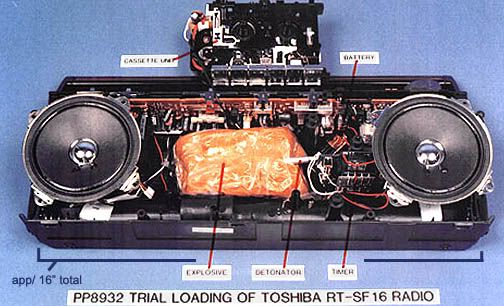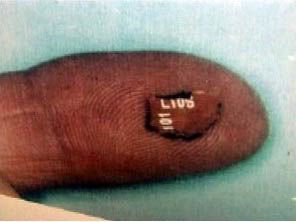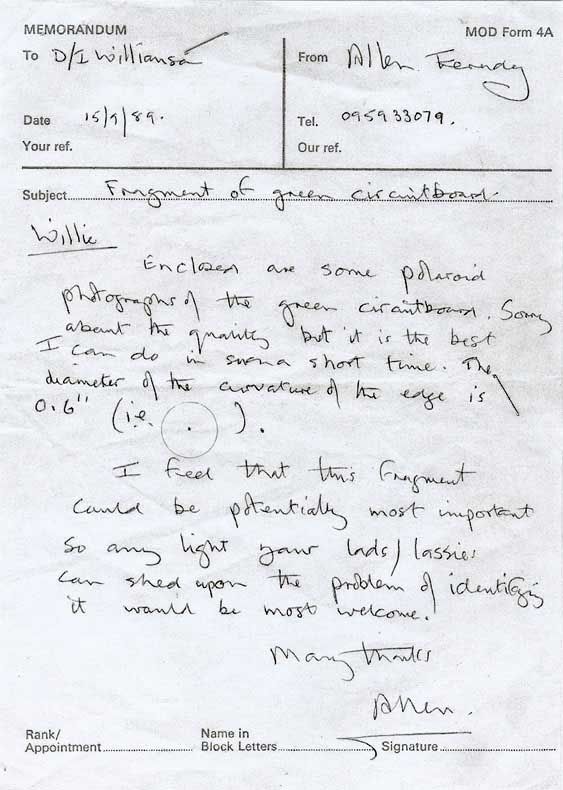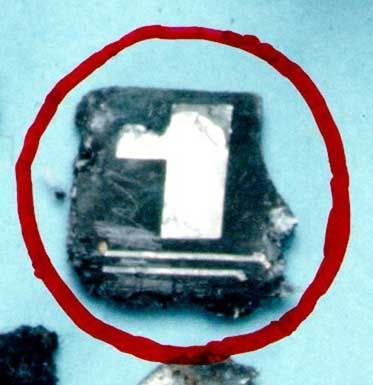last updates June 11/13 2011
A few days ago I posted a collected timeline of forensic finds and coclusions from RARDE's "scientists" Dr. Thomas Hayes and Mr. Allen Feraday. These were supposed to have led to the identification of a vaguely Libyan radio model holding the bomb - Toshiba BomBeat RT-SF16. The end result is bizarre, with a hundred implied complications, like those presented by a tiny bit of blasted circuit board dubbed PT/30.
This 3mm x 4mm fragment was allegedly found on June 8 1989 by Dr. Hayes, or June 18 by Feraday, depending. Both versions match on where it was found - embedded in a piece of soft blue American Toursiter suitcase owned by victim Karen Noonan and labeled PK/2128. [Leppard p207] Its PT number is lower than the famous PT/35 found weeks earlier (on paper), as noted by the defence at trial. This would be unusual if not for all the rest being just as out of order (see PT/31, PT/56, etc...). Stranger yet, Dr. Hayes' examination notes of PT/30 read in part:
It has been partially delaminated by the blast and, hence, does not possess the expectedgreen lacquer and/or solder tracking upon its rear face as this has been ripped completely away. The upper [brown] face of the fragment bears part of the white painted characters C32 and a depiction of an electrical resistor.Consider the sample loading of the alleged bomb (below) in a normally-assembled RT-SF16 radio (minus its cassette assembly). The main circuit board is the one seen along the top, brown-colored component side down. This surfaces is that painted with little white markings that survived the blast of that Semtex about one inch distant. It was the inverse side, green lacquered and tracked with solder, that was blasted away. Was the board backwards?
PT/30 is not alone in having its painted face survive readable and unburnt. Consider this largest portion of the earlier find AG/145 (at right). Its markings "L106" and "101" are plain as day, and only the edges are burnt a little. The smaller part of AG/145 is similarly marked, with "02." It would thus seem the terrorists allegedly scraped off all those little components off their contacts and flipped the board backwards to fit it back in. Except that the AG/145 fragments also had nice green backsides that showed no sign of blast either, and allowed the first identification in February.
Anyway, to bring this back to Feraday, he was reportedly excited about PT/30 turning up. The radio model RT-SF16 was already identified on May 11, we hear, and this fit it just as perfectly as the AG/145 fragments did, and was noted immediately by Hayes on June 8. So Mr. Feraday reportedly waited a few months, and then in September took the thing to the evidence holding facility Dexstar to see if it could match anything there.
Later, in December, DI William Williamson sent SIO Henderson a memo describing this: "On his visit to Dexstar on 14 September 1989 Mr Feraday viewed a large number of items of circuitry which had been withdrawn for his examination; none of these items was a match for PT 30." [Leppard p 207] (note: PT 30 is just Leppard's way of writing PT/30 - space instead of slash. It's the same item)
Williamson went on to ask Henderson to look into inspecting evidence held by the Germans to see if a match could be found to Khreesat's work - particularly some alarm clocks he was known to have bought. Feraday had "on a number of occasions repeated his keen interest in any item of circuitry," Williamson explained, "or indeed in any digital clocks or other similar items which could contain a circuit board for examination and comparison at RARDE against produsction PT 30." [Leppard 207-208]
Earth to Allen, your science guy Hayes has May 11 as the date he IDd the radio, and on June 8 found that PT/30 matches it. Why the running around drama in mid-September looking for some whole other fit? The obvious answers somehow elude this blogger, but one thing I notice is the timing of this fevered search relative to a more fruitful circuitry quest: PT/35(b), the lucky corner of a Libyan MST-13 timer main board. The day after Feraday's reported inquest at Dexstar, evidencing that "keen interest" in circuit board clues, he sent a memo to the same DI Williamson cited above. This was regarding a four-month old (on paper) find by Dr. Hayes.
In retrospect, this memo is rather vague, not mentioning PT/35(b) by name or giving many direct clues. It could almost be about PT/30, except for the cited curve. Only the mammoth MST-13 chunk and its double-underlined #1 is large enough for that detail. By my rough measurement of a scaled MST-13 jpeg the curve at upper right has a 0.5" diameter. I'd defer to Feraday here.
So this is a letter about that amazing but yet unidentified clue PT/35(b), keenly ignored it seems until that date - four months after the paperwork shows it found. But only one day after Feraday's own foray over the already identified PT/30 (says the same Williamson months later).
Or am I just making too much out of a simple mix up? Not likely, as that memo of December 19, just ahead of the anniversary, shows Feraday behind the scenes urging yet more bogus action over the already identified circuitry. Over six months following its match-up with the known bomb radio, he was pestering Williamson to pester Henderson about trying to find a match for PT/30 over in Germany if possible.
If all these things are the true exploits of professional and even-handed investigators ... my God, what kind of MKULTRA experiments were they doing with the ventilation at RARDE? No, these "facts" must have appeared as they were convenient, with little regard for those which came before or after. It's the only sane explanation.
---
Update June 11/13, 2011
Some amazing screen grabs from Al Jazeera English's new video.
AG/145 fragments, separated and partly cleaned, hugely magnified and looking less burnt to ash than ever:
Here's the second largest fragment, placed against its spot of origin on the brown/orange, lettered, blast-ward side of the board.
And here is the backside of the larger one against the green, shielded, solder-tracked side.
It's this precise match-up, Allen Feraday said, that helped him at least narrow down the radio model by mid-February 1989. In both images, note the material - flimsy, paper-fiber-and-resin, not fiberglass.
As we can see comparing the first and third of these images, neither side of that largest bit shows any sign of blast damage (extreme heat, for example). But where on the board are these fragments from? The middle, just one inch from the Semtex supernova? Or at one of the ends, a couple of inches away? There's an image that clears that up, and they showed it as well in the video, bless them. I compared it to the assembled IED mock-up, rotated so features matched. I then indicated the rough areas for both AG/145 and PT/30.
That gives at most about 1.5 inches for the blast wave to chill-out, and nothing but the flimsy little capacitors (or ??) attached to those spots to shield the face. The left-hand one is in as good a spot as it gets to survive, but still, I can't cite the measure of the force of this blast except that it ruptured an airliner's hull at two feet distant, after being slowed by the luggage container, the suitcase, the clothing, and the radio's case. Before all of these, at 1.5 inches, tops, fresh and full-force ... No way.
Beyond that, do recall, as explained above, that Hayes found PT/30 had the wrong side - the green one - blasted away, while all of AG/145 shows damage to neither side. Another oddity is that both AG/145 at PT/30 would go about the same direction in the blast wave - out from the center in all directions. If PT/30 were blasted straight down, AG/145 should go down and to the left pretty much.
Officially PT/30 wound up wedged into the outer frame segment (IIRC) of the blue softshell on the container floor, just beneath the bomb bag - if so, why would AG/145 wind up, as Mr. Thomas Claiden testified, blasted into a fold of the data plate, on the outside of the container, halfway up its side, two feet or more above the bomb bag?
---










6 comments:
There is an interesting article in today's edition of the 'sundayherald', 'New doubts over crucial evidence in Lockerbie trial', http://www.heraldscotland.com/news/home-news/new-doubts-over-crucial-evidence-in-lockerbie-trial-1.1112514? (unfortunately the full article can only be read if you Sign In). The following are some excerpts from that article -
'...During the trial, Dr Thomas Hayes, an expert witness for the prosecution, testified that a fragment allegedly from the bomb's timer had not been tested for explosive residue.
However, according to the memo, tests were in fact carried out - and proved negative.
...
A previously secret memo, dated April 3, 1990, describes a visit to the Lockerbie investigation by French police officers examining the 1989 bombing of a French airliner in Niger. The memo states that Detective Superintendent Stuart Henderson, senior investigating officer, told the French delegation "that the piece of PCB [printed circuit board] from the Toshiba [cassette player] bore no trace of explosive contamination and that this was due to the total consummation of the explosive material. Similarly with PT/35, the item was negative in regard to explosive traces".
...
The police memo was one of hundreds of documents appended to the 800-page report into Megrahi's conviction produced by the Scottish Criminal Cases Review Commission. However, its potential significance was apparently overlooked.
I am afraid my mate John Ashton misses the central point.
Your article uses as a source page 207-208 of David Leppard's "On the Trail of Terror" published 1991.
It seems you have missed what I had long missed. Only on seeing the "new" page 51 ("dated" 12/5/89) of Dr Hayes notes in Professor De Braeckeleer's recent article "Was Key Lockerbie Evidence Antedated" did the penny drop. According to Leppard Hayes discovered the fragment no earlier than June 1990! For the benefit of readers who do not have a copy I will reproduce what Leppard wrote starting at the bottom of 208. It is fascinating!
"As 1990 progressed all the promising leads which seemed to be coming together began, one by one, to run nowhere. If the investigation seemd to have taken on a dynamic new life in the autumn of 1989, by the early summer of 1990 progress had once more ground to a halt. There was still insufficient evidence to make a trial of the suspects possible."
For months Orr's dwindling team of detectives - by June 1990 there were just 50 of the original 130 left on the inquiry team "
- "With no 'supergrass' about to inform on the rest of the bomb gang, the atmosphere at the Lockerbie incident centre began once more to change to disillusionment and despondency.
Then suddenly RARDE made an astonishing breakthrough. In his laboratory Thomas Hayes, who after his retirement had been retained by RARDE to work as a a consultant on the inquiry, finally identified a tiny piece of micro-circuitry as being part of the bomb's triggering mechanism.
'It was not part of a detonator but it was a piece of the means of timing and powering the bomb' one RARDE source close to the inquiry confirmed. The piece of circuit board appeared to be part of a timing device manufactured by a Swiss company.
Hayes said:
It goes without saying that because of the force of the explosaion and the nature of the explosion that all the items that in the main were recovered from within a very close range of the detonating explosives would of necessity have been very small indeed, and therefore would have taken a lot of finding and interpretation, i.e. the need for careful microscopic study."
(According the the "new" page 51 on the 12/5/89 Hayes not only recovered PT/35 (b) but also TP2 a "multilayered fragment of white paper bearing writing in several languages which miraculously had survived the explosion" - Baz)
Hayes continued
"The recovery and identification have quite a large time lapse between them simply because it took that time for identification. That is the nature of the game with forensic science and particularly the case in this investigation. There were quite a number of items which initially we didn't have a clear idea what they were and that only by scratching your head over a period of time and piecing things together do the answers become clear."
Leppard continues -
Hayes had spent many months scratching his head before committing himself to a positive identification of the timing device. when at last he did American intelligence analysts prepared an assessment of the likely source of the circuit board.
Vincent cannistraro, the head of the CIA's counter-terrorism centre - told the LICC that the assessment indicated possible similarities with a batch of timing devices recovered from two men arrested in Senegal in early 1988. -
n August (1990?-Baz) Stuart Henderson sent officers to Senegal to retrieve photographs and control samples. When they returned the samples were sent to RARDE.
The comparison did not take long. When he got the confirmation Hayes looked up from his microscoscope elated. It was the crowning glory of RARDE's forensic inquiry.
Out of time will complete this comment in a few days!
20 years ago whilst giving evidence as a purported "supergrass" a scumbag of my acquaintance. Solicitor and Barrister Warwick Reid said "you lay a lie along the edge of truth".
Recently my new best mate and darts partner Rolfe kindly suggested that I look at Feraday's memo of the 15th September 1989 featured in your excellent article. I am glad he did.
From Leppard I was aware of Feraday's discovery of a fragment of circuit board in Karen Noonan's suitcase on the 18th June 1989 (PT/30) and his visit to Dexstar on the 14th September 1989 to look for a matches. I assumed the memo of the 15th September 1989 (not mentioned in Leppard) was to follow this up.
Professor De Braeckeleer's recent article features the "new" page 51 dated 12/5/89 of his notes and page 112 of the 10/10/89 both concerning the examination of fragmrent PT8932. At page 52 he discoverers the two remarkable exhibits "a fragment of a green coloured circuit board" and a"multilayered fragment of white paper bearing writing in various languages."
According to Rolfe having discovered these two key exhibits in "part" of PT8932 Hayes (having to dash off to watch Coronation Street or something) doesn't make a contemporaneous note. Five months later he decides to examine the other "part" of the fragment labelled as "charred trousers or similar" and discovers the "Slalom" label (which he had missed before). Unfortunately this "further" examination reveals only "small fragments of blackened debris".
I am mindful of Edwin Bollier's claim of a double deception, that the fragment of MST-13 time he was shown was originally black (a prototype) but morphed into green circuit board.
While your article features the hand written memo of the 15th September 1989 I do not know if this is a photograph of the original or a photograph of a photocopy. As you point out its contents are vague. Does it relate to PT/30 or PT/35(b)? There is no reference to the fragment or photographs.
At the start of your article you quote Dr Hayes' examination notes of PT/30 that PT/30 "does not possess the expected green laquer."
Yet the memo clearly refers to green circuit board. I cannot comment on the curvature.
Would it not be extremely odd if having discovered PT/35(b) in May 1989 RARDE made no attempt to match it with other exhibits recovered?
I was inspired by Rolfe's belief that the memo is evidence that PT/35(b) was "in the system" in September 1989. That is precisely what it was created for! It is a clever and deeply cynical fake concocted to dupe the gullible and the complacent. (Lord Advocates, Camp Zeist Judges, FBI investigators.)
Hayes examined PP 8932 on the 10/10/89. He identified it a piece of Slalom cloth but found nothing beyond "blackened fragments."
The "new" page 51 was created much later. When the pages were renumbered however can be deduced from the dated when the renumbering stopped on page 56. Perhaps the "new" page 51 was not the first draft.
Feraday discovered a genuine fragment (PT/30) on the 18/6/89 and on the 14/9/89 went to Dexstar. Perhaps on the 15/9/89 he sent a memo to DI Williamson seeking the assistance of the "lads/lassies" attaching polaroid photos. If this memo existed it must have been destroyed. The memo featured in your article was created to give credence to the "new" page 51 and Hayes bogus "discovery".
The import of your article is that it is curious Feraday was making such enquiries 4 months after the exhibit (PT/359b) was found, but it wasn't "found" in May. It was created some time later.
As a p.s. (that wouldn't fit in the above) may I raise the matter of the News Corp phone-hacking scandal?
The lead article in last Sunday's Sunday Times (a News Corp paper) was written by the ST's long serving reporter David Leppard.
Leppard is no fool and from my personal experience ruined a great story to keep a friend of one of his colleagues "out of the frame".
Having written "On the Trail of the Terror" if he was following the trial a decade letter he must have known that Hayes was lying when he claimed to have discovered the MST-13 fragment in May 1989 but not a peep from him and indeed the ST has always followed the official version of events (whatever that happens to be at the time!)
Of course Hayes and Feraday's don't just put themselves in the frame but a lot of other people. (Not to mention what will happen where other people were convicted on the evidence of Hayes & Feraday.)
Now I understand there are allegations that News Corp may have hacked the phones of the saints and martyrs who perished in the 9/11 attacks, a revelation which if true would destroy News Corp.
However those truly wonderful people at the FBI are investigating this without fear or favour.
Remind me - how did the FBI Director get his big break?
Mr. Follon, thanks for that. I saw it brought up (and cited at length, plus the new photo of PT/35(b)) at the JREF forum, but haven't read it closely yet. I've been massively sidetracked by this insane regime change campaign that's going for what Lockerbie was never able to do.
It's a little strange that a test that could come up negative was ever allowed, or that Henderson gave its results the time of day. There must be a back-story - the Germans did it behind the Scots' back somehow, etc.
But the explosives consumed themselves? While leaving bits of PCB an inch away? And leaving residue, if I'm not mistaken, all over the luggage container and airplane hull ruptured by still-expanding gas, despite being completely consumed within about one inch? Bizarre ...
And the SCCRC, having this, found nothing amiss with the timer fragment? Maybe it's the rest of us that are missing something, like where Henderson said "APril Fools!"
To add: April Fools was a joke, but hey ... the visit was only two days too late. Hmmm...
And by "Lockerbie" I meant the political investigation of it and this political science that underpins it. I think it was designed both to obscure the truth, and to attack Libya's government in as many ways as possible, mostly economic. And as the 1996 CIA/PFSL/MI6/al Qaeda overthrow effort shows, this was to turn the world and their people sour against them, and soften them up for overthrow.
On to Baz ... may answer in two parts, or in brief.
A small point: the fragment examined on "page 51" is PI/995 (I think?) - 8932 (PP8932?) is the case number, and is on all trial photos.
So with:
"Hayes examined PP 8932 on the 10/10/89. He identified it a piece of Slalom cloth but found nothing beyond "blackened fragments.""
What is that? Not the same collar, PI/995 surely? If so I'd like to know more...
Other minor details, close enough. Main thing is, as you can see, this is a strange memo. You'd think it would refer to PT/30 by what Leppard has. But the curve is in reference to 35(b) (that's about the exact scale of it) and as you note (good catch, I don't think I did), PT/30 wouldn't be called "green," with its green lacquer missing.
I'm not averse to seeing this thing in the chain in September or even in May, hypothetically. Plenty was being planted in those days, I suspect. But I'm not sure even this memo isn't backdated. No firm opinion.
Yeah, I'll do a part 2 later ...
Post a Comment